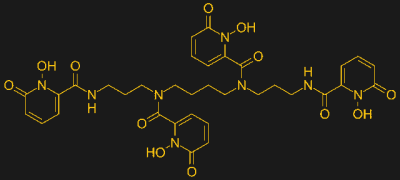It perhaps goes without saying that one nuclear bomb can really ruin your day. The same is true for non-nuclear dirty bombs, which just use conventional explosives to disperse radioactive material over a wide area. Either way, the debris scattered by any type of radiation weapon has the potential to result in thousands or perhaps millions of injuries, for which modern medicine offers little in the way of relief.

But maybe not for long. A Phase 1 clinical trial is currently underway to see if an oral drug is able to scour radioactive elements from the human body. The investigational compound is called HOPO 14-1, a chelating agent that has a high affinity for metals in the actinide series, which includes plutonium, uranium, thorium, and cerium curium. Chelating agents, which are molecules that contain a multitude of electron donor sites, are able to bind to positively charged metal ions and make the soluble in aqueous solutions. Chelators are important in food and pharmaceutical processing — read the ingredients list on just about anything from a can of soda to a bottle of shampoo and you’re likely to see EDTA, or ethylenediaminetetraacetic acid, which binds to any metal ions that make it into the product, particularly iron ions that come from the stainless steel plumbing used in processing equipment.
The compound under evaluation, HOPO 14-1, is a powerful chelator of metal ions. Its structure is inspired by natural chelators produced by bacteria and fungi, called siderophores, which help the microorganisms accumulate iron. Its mechanism of action is to sequester the radioactive ions and make them soluble enough to be passed out of the body in the urine, rather than to have the radioactive elements carried around the body and incorporated into the bones and other tissues where they can cause radiation damage for years.
HOPO 14-1 has a number of potential benefits over the current frontline chelator for plutonium and uranium toxicity, DTPA or diethylenetriaminepentaacetic acid. Where DTPA needs to be injected intravenously to be effective, HOPO 14-1 can be made into a pill, making stockpiling and administering the drug easier. If, of course, it passes Phase 1 safety trials and survives later trials to determine efficacy.
















https://en.wikipedia.org/wiki/Dirty_bomb#Tests
Dirty bombs are complete BS FYI
Agree, pesticides are far worse offender. My friend would make a cup of coffee, bring it back to our room, go for a smoke and then drink it while working. Little did he know that with every cup he was sipping a dose of some 1980s weed killer I found while cleaning my garage. Over three years his health kept getting worse until he was finally let go from work. Now he’s on permanent disability leave.
Little did you know that your friend identified as a broad-leaf plant!
Did you just confess to poisoning your roommate and destroying his life? Maybe you should seek professional help.
Sure, assuming that no one designs a more effective one.
nah they are pretty much flawed by design
A single source from a single newspaper from the same country the research was done in posted on wikipedia in 2015.
Incredible.
If you’ve done your own tests, it would be great to see the results…
I agree one data point is not much, but the problem is, very few countries would be willing to do the tests.
I’m not claiming its incorrect but the russians were literally just poisoning themselves in chernobyl digging in the soil so we do know explosion + material = exposure.
A dirty bomb doesn’t need to be a bomb-bomb. It could be a pringles can with a spring and hazardous material inside that flies out when opened.
Woooww a pringle can with a dispersion radius of 0,5 m sounds REALLY dangerous …..
i think there are multiple points here that make me question why this is even newsworthy.
the problem with a dirty bomb is multiple:
-availability of “lethal” radioactive material
-bomb dispersion
-absorbtion and bioavailability
-“oops the wind changed direction” aka they don’t scale well
these points alone (the are for sure more) make dirty bomb a a big meh on the danger scale. there is a reason they are classified as weapon of mass disruption and not weapon of mass destruction. a well placed virus on the other hand……..
so in summary an antidote sounds nice for accidental poisoning but not sure how this translates into an cure for dirty bombs.
Yep! and lest we forget Brazil https://en.wikipedia.org/wiki/Goi%C3%A2nia_accident AND in Mexico too: https://en.wikipedia.org/wiki/Ciudad_Ju%C3%A1rez_cobalt-60_contamination_incident
I don’t fear a dirty bomb attack but all those rusty nuclear power plants of Belgium and France which are very close to the German border.
Good thing is in summer half of Frances nuclear power plants are shut down because the rivers are low and/or too warm. At least I hope a shut down plant bears less risk of exploding :)
General civil consequences of a dirty bomb would be a little more limited at the present time as most people have easy access to masks which would limit aspiration of dust. As we get back to the normal of pretending pandemics don’t exist, then this protection will also decrease.
So how’s it working out for you now you’ve shut down all your reactors? Make sure to cut the cable to France as well so you don’t accidentally end up using any of their clean electric. Same for the cable to Sweden.
Meanwhile, be happy in the knowledge that your dirty coal fired power stations release more radioactivity in the the environment than any nuclear power station has.
How is it a good thing that Germany has to burn even more coal and Russian gas in the summer because France doesn’t have ENOUGH nuclear power?
No nuclear plants have any “risk of exploding”, so no – a shut down plant isn’t any less likely to “explode”.
No nuclear plants have any “risk of exploding”
Have you seen any of the footage from Fukushima Daiichi…?
How many people died as a result? Casualties from Fukushima were astonishingly low, limited mostly to onsite workers and engineers.
I’m sorry but I’ll take that over a smoke stack any day, even a natural gas one that *only* causes global warming.
Read further in the same Wikipedia article and you’ll see mention of an incident in Brazil where two guys broke into a clinic and stole caesium chloride, and ultimately ended up contaminating 247 other people. That’s the bigger issue – secondary contamination after-the-fact, as opposed to contamination in the initial incident. That stuff will spread, no matter how well the initial incident is contained.
OTOH, I’ve never thought an explosive was the most efficient way to contaminate a large area, unless if was a very large explosive. A crop duster, the water supply system of a large city, or the HVAC system of a sufficiently large building would be more efficient dispersal methods.
Similarly (one of) the Russian poisonings in the UK where they discarded the poison vile in a rubbish container and some folks at the lower end of society went rummaging and found it. Didn’t end so well for them unfortunately.
Dirty bombs are mainly a psychological weapon. In that regard they are effective. They will cause a population fear, anxiety, and a huge waste of resources dealing with it.
Exactly, a weapon doesn’t have to kill many to be effective, it can just scare many.
says who?
Part of the British atomic testing at Maralinga in the SA far north was the long term effects of fallout on a civilian population.
Some of the tests were not actual Nukes going off, but looking at the spread of nuclear materials when hit with conventional explosives.
Uni SA is still monitoring air quality in Adelaide, looking for strontium 90 and other things like plutonium. People like Sir Mark Oliphant and others, made a fuss.
the Brits stopped sharing data, they kept on collecting data though.
the Women and Childrens Hospital in North Adelaide attracted a lot of shyte for removing a single knuckle bone from still born babies, measuring the amount of strontium 90 present.
Even after the outcry, they are still doing it.
Eventually the Brits did the right thing and cleaned up “most” of the contamination.
When we have a big dust storm blow down from the far north, the background count goes up
Depleted Uranium is for real… just a slower death
Oh boy will the radioactive ions be pissed if this works out :o)
I’d give you a star if I could.
And you won’t even have to turn on the bathroom lights.
Nuka Cola Quantum?
Chelating agents usually stay in the stages of experimental treatment because there isn’t enough demand to justify getting them further approval. DTPA has been around quite a while and you still need to sign a release form agreeing to use experimental treatment before getting it.
That first sentence was delightful.
My powers of understatement are the stuff of legend.
While it’s an entertaining idea for an action movie that some run of the mill terrorist will spread plutonium over a large area, it is simple not ever likely to happen, it takes state actors to create any measurable amount of plutonium, and those who are actively working on it, and know the price tag of it, will not be wasting it on something as utterly inefficient as a dirty bomb.
There are sources that are far more likely, and absolutely lethal, such as strontium-90 from abandoned/lost soviet RTG’s to cobalt-60 sources used for industrial and medical purposes, both require relatively short exposures to be fatal from external exposure, no internal absorption needed, both could be broken up into many smaller pieces and still be dangerous, of course at great risk to anyone foolish enough to approach these sources to break them up. As far as iodine-131 goes you are not likely to come across that to an extent where potassium iodide pills will make any difference, it’s a fission decay product and would only be present if they managed to create an actual fission bomb, or at least a partial one, for anything else the only place you might see it would be small amounts in medical settings where it is ironically is used to treat thyroid cancer.
Great it stops you getting bone cancer or leukemia, but guarantees that you get kidney and bladder cancer instead. Just as we learned recently that there is no real way to stop the spread of a bioweapon there is no real way of protecting yourself from an airborne radiation hazard short of hermetic isolation.
They call it Hopo because they hope every country will order enough to dose every citizen. Then they change their names and move to their secret island lair.
Not really going to help the dirty bombs made with Cesium-137 from medical equipment bought at auction for scrap prices….
Needs to be renamed… Hyronalin and made available in hypospray form. One hypospray will protect you from all types of radiation including Bertold rays and Metaphasic and Thaleron radiation. 🖖
No living eukaryotic tissue can withstand Bertold rays for any length of time. It has led to the abandonment of at least one agricultural colony and their nearly complete efficacy is the reason why ships are periodically sterilized using them.
But somehow goofballing a random spore from the ugliest damn plant in the galaxy is enough to reverse the effects of Bethold rays and turn a Vulcan into a tree-climbing schoolboy.
“[A] chelating agent that has a high affinity for metals in the actinide series, which includes plutonium, uranium, thorium, and cerium.” — cerium is not in the actinide series, it is in the lanthanide series (source: https://en.wikipedia.org/wiki/Cerium). I would suggest sticking exclusively to your specific area of expertise next time.
Ah yes, a simple mix-up between cerium and curium. I’ve fixed the text thanks to your kind and thoughtful feedback, and rest assured I’ll hang my head in shame over this single-letter error.